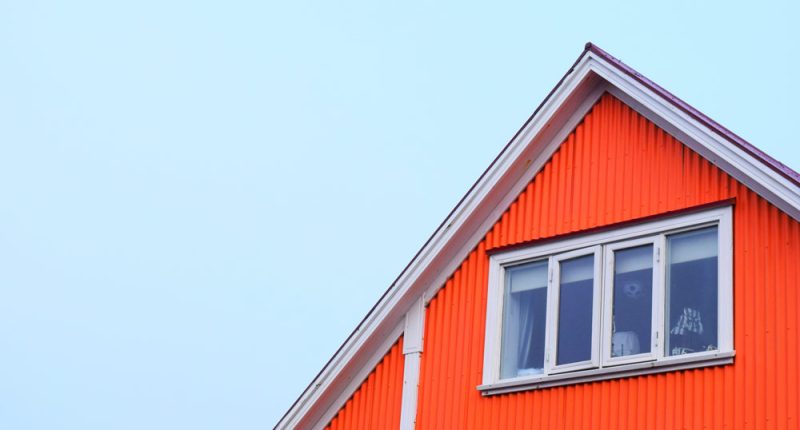
Palm Coast’s decades-old discrimination against colored houses may be over.
In a remarkable vote on Tuesday, the Palm Coast City Council unanimously agreed to repeal almost all restrictions on exterior house colors in place since before Palm Coast was a city. The requirement of only two base colors and some accent-color allowances will remain. Murals will still not be allowed.
The repeal is nowhere near final. It requires a rewrite of the ordinance, a hearing before the planning board, and two more hearings before the council. The planning board had already rejected recommending a proposal that would have repealed all restrictions except for five banned colors–neon, fuchsia, magenta, orange and purple.
The vote was a victory for Mayor Mike Norris, who pushed hardest for the repeal–he’s been pushing since January–and who passed the gavel to make the motion for it after Council member Theresa Pontieri withdrew her motion to approve a looser, but still restrictive ordinance.
“I don’t think we should be dictating what people’s house colors are,” Norris said. “It’s a silly ordinance.” He said color “is too subjective. That’s why I would want to get rid of it completely. That’s been my approach from the beginning.” He said people who want color restrictions can move into homeowner associations.
Norris got cheers from the floor as he made the motion, worth restating here as it ends an era: “I make a motion that we remove all color restrictions on houses in the city of Palm Coast,” Norris said. “If you want color restrictions, move into an HOA.”
The restrictions date back to when Palm Coast was an ITT subdivision and ITT ran an Architectural Review Committee. The Palm Coast Community Service Corporation formed in 1993 continued the color restrictions, which were codified into the city’s ordinances in 2005, six years after incorporation.
Current standards have gone through a dozen hearings between the planning board, the beautification committee and the council, according to Acting City Manager Lauren Johnston, who did not hide her exasperation. “When we talk about government efficiency and spending a lot of time on things,” Johnston told the council, “this requires now three more public hearings. So just letting you know that’s more staff time and costs on this particular item.” She may have been overstating the issue a little: the new ordinance is more of an editing job than a rewrite, though it still opens the possibility of further lengthy debates and, given the issue’s history, reversals.
The measure that had been before the council was not for repeal, but for adoption of a revised ordinance that kept banned colors in place and expanded allowances for other colors.
Pontieri made a motion to approve the proposed ordinance and Council member Charles Gambaro seconded. “This isn’t a new ordinance,” she said. We’re being more lenient on the current ordinance that is already in existence, and for all of the people that have said that they want no color restrictions, I will tell you: I’ve been contacted by a lot of people who say, No, we moved here because there are color restrictions.” She termed the ordinance “a strike of a reasonable balance.”
But she was also nervous about subjective opinions on color: “We either have to allow everything, or we don’t, we have to draw a line in the sand,” she said. The city’s standard based on “light reflectance value,” or LRV, provides a more objective approach, she said.
Council member Dave Sullivan was uncomfortable with the ordinance. He wanted it tabled so allowances could be further broadened. That would send the ordinance back to the starting point, with a first appearance before the planning board. With Council member absent, the proposal appeared to be headed for a 2-2 vote, so it would have failed. Pontieri was anxious to get the issue resolved.
The response from the public to the amended but still-resrictive ordinance may have turned the tide.
The totality of those who spoke on the proposal was strongly against regulating colors. Opinions fell within the spectrum of Eddie Lang’s comments to the council: “I think this ordinance is ridiculous. Who are you or anybody else here to tell us how to paint our home? It’s our home,” Lang, a Realtor, said. “No one is asking to paint their home neon pink with glitter trim, as much as that might be cool, but when a homeowner wants to go a little outside the narrow band of taupe, gray or approved oyster, they shouldn’t need to submit to what feels like a design tribunal.” He added: “f we’re worried about property value, let’s remember curb appeal comes from well maintained properties in vibrant communities, not from color conformity that would make paint store that make a paint store cry.”
Others called the color restrictions “unfair” and counter to “freedom of expression.” Even Annamaria Long, the executive officer of the Flagler Homebuilders Association, spoke in favor of greater color freedoms, dismissing claims that more colors bring down property values. “Flagler Beach, or any beachside community is also a really good indicator of that, because they have color,” Long said. “I joke that a bunch of drunk old guys must have designed the street names here, but then you go through those sections, and then it’s beige on beige on brown on tan on white, and it just gets a little–little boxes full of people sitting in their homes, and I would love to see a vibrant community with everyone outside.”
Mindy Melendez, too, spoke: she has been at the center of the debate, having received a violation over her house’s dark-blue color. She called for grandfathering the new ordinance. “What’s especially concerning is the lack of consistence of enforcement,” she said. “There are multiple homes within the city that have the same color or similar colors as mine, which have been painted longer than mine, but yet I am the one who received the citation. The only difference in my case [is] that a neighbor filed a complaint. That raises serious concern about selective enforcement, which can be a legal issue in itself.”
At the beginning of the discussion Norris thought he was going to be in the minority, Now he felt confident enough to push for the repeal, which required Pontieri to withdraw her motion. She did so. Norris passed the gavel and made his motion, which he was willing to amend to keep the five prohibited colors in place.
Pontieri didn’t want the half-measure at this point. “I’m of the opinion that if you’re going to say we’re not going to have exterior colors, then you shouldn’t be picking and choosing prohibited colors,” she said. “Because who am I to say that, No, magenta is more offensive than blue. So if you’re going to get rid of all of them, I think you just have to get rid of all of them, to be fair, and take the subjectivity out of it.”
So the vote was unanimous for repeal.










